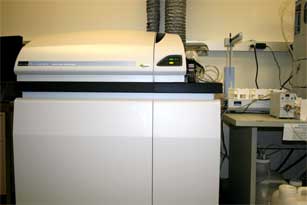|
|
The Geochemical Research Laboratory at the University of South Florida specializes in the determination of trace metals in a varitey of materials including water samples, environmental samples (e.g., soil, sludge) and most rock types. Instrumentation includes a Perkin-Elmer Elan DRC II Quadrupole Inductively Coupled Plasma Mass Spectrometer with coupled Cetac LSX 213 Laser Ablation and Perkin-Elmer S-200 High Performance Liquid Cromatograph, Perkin Elmer Optima 2000DV ICP-OES and ARL DCP-OES. Additional equipment available include AFS, XRD and an Ion Choromatograph. We provide analyses to the public, research institutions, government agencies and universities.
For more information please contact Dr. Zachary Atlas.

Sample Preparation
Solid samples may need to be dissolved into an aqueous medium prior to analyses on the ICP-MS. We employ a variety of acid digestions, flux fusions and isotope dilution methods whose application depends on the sample matrix and elemental emphasis. We maintain two analytical "wet labs": one for the routine dissolution of rock samples for compositional study, via classical fluxed-fusion methods; and another "clean" laboratory maintained as a B, Li and Be - free space, which we use to prepare samples for light element analysis, for ultra-trace element determinations by ICP-MS, and for the preparation of samples for Li and (soon to come!) B isotope ratio determinations.For more information please contact us.
Quality Control
The University of South Florida Geochemical Reseach Laboratory employs the strictest quality control methods available. We use only certified reference materials where applicable for both standard calibrations and QC standards. An independently certified standard is inserted not more than every twenty samples to ensure ongoing running accuracy. All standards and reagents are purchased by reputable sources and are diluted with de-ionized type I reagent grade 18 Megaohm*cm-1 resistance water or better. Distilled acids are produced in our clean room facilities and use readily in cases where determination of low concentrations (< 1 ug/L) is required. Accuracy of the testing is guaranteed. More details about our methodology are available upon request.
Additional Facilities
Also available at USF are tools for the determination of mineralogy and mineral compositions. We maintain a Rigaku tabletop X-ray powder diffractometer for the examination of mineralogical unknowns via powder mount and smear slide methods. We are also well-equipped with research grade petrographic microscopes with both transmitted and reflected light capabilities; an automated heating-freezing stage for fluid inclusion studies; an automated system for thin section photography; and several modern binocular microscopes with photographic capabilities.
A recent addition to the USF analytical arsenal is a remotely-operated Electron Microprobe/Scanning Electron Microscope (EMPA/SEM) system. The instruments, a state-of-the-art JEOL 8900R SuperProbe, and a JEOL 5900-series SEM, are housed at Florida International University in the Florida Center for Analytical Electron Microscopy (FCAEM) , and were obtained via a collaborative NSF grant for the use of geoscience faculty at all the major Florida universities. The system is run from desktop computers via an Internet 2 high data density connection, and provides full, real-time optical and backscatter graphics, as well as the full spectrum of quantitative micro-analysis options. We are currently establishing a sample preparation lab for probe-SEM work in the Geology Department currently.
|